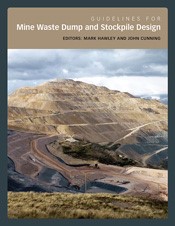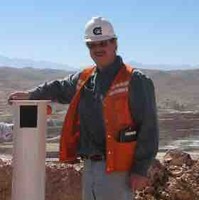This book is a comprehensive account of the current state of practice and provides insight and guidance to mine operators, geotechnical engineers, mining engineers, hydrogeologists, geologists and other individuals that are responsible at the mine site level for ensuring the stability and performance of these structures. Readership includes mining engineers, geotechnical engineers, civil engineers, engineering geologists, hydrogeologists, environmental scientists, and other professionals involved in the site selection, investigation, design, permitting, construction, operation, monitoring, closure and reclamation of mine waste dumps and stockpiles. This book:
- Provides comprehensive coverage and current state of practice for the engineering issues associated with mine waste dumps, dragline spoils and stockpiles.
- Offers practical guidance and essential information on the latest technologies and innovations for all those involved in the investigation, design, operation and monitoring of mine waste rock dumps, dragline spoils and stockpiles.
- Developed and written by industry experts with extensive knowledge and experience in mine waste rock dumps, dragline spoils and stockpiles associated with large open pit mines.
- Provides comprehensive guidelines for slope design practitioners, written in an accessible style and extensively illustrated.

Mark Hawley
John Cunning
Chapter Outlines
This book, Guidelines for Mine Waste Dump and Stockpile Design, is the third book in the LOP Guideline Series and focuses on the investigation, design, operation and monitoring of waste dumps, dragline spoils and stockpiles associated with large open pit mines. This book has been written by a consortium of geotechnical consultants and individuals including Piteau Associates Engineering Ltd, Golder Associates Ltd, Schlumberger Water Services, and Sherwood Geotechnical. It comprises 16 chapters that follow the life cycle of a mine waste dump, dragline spoil or stockpile from site selection to closure and reclamation. It describes the investigation and design process, introduces a comprehensive stability rating and hazard classification system, provides guidance on acceptability criteria, and sets out the key elements of stability and runout analysis. Chapters on site and material characterisation, surface water and groundwater characterisation and management, risk assessment, operations and monitoring, management of ARD, emerging technologies and closure are included. A chapter is also dedicated to the analysis and design of dragline spoils.
This section reviews historical context and some of the earliest work on developing a formal understanding of the mechanics of mine waste dumps in response to the failure.
This chapter provides an overview of the design process and main inputs. More detailed descriptions of each of the key components, including various methodologies and analytical techniques that can be applied to help develop rational and defendable designs, are provided in subsequent chapters.
This chapter revisits and further develops the concept of a stability/hazard classification system or index based on the 1991 DSR system, and lays out the basis, structure and attributes of the proposed new waste dump and stockpile stability rating and hazard classification (WSRHC) system.
This chapter describes the typical site characterisation and field investigation studies that are carried out to support the planning and design of mine waste dumps or major stockpile facilities. Site characterisation may include physiography, geomorphology, climate, surface water, groundwater, geochemistry and geotechnical conditions, all of which may be important during the site selection and facility design process.
This chapter describes material characterisation carried out to support the planning and design of mine waste dumps or major stockpile facilities. Characterisation of the materials upon which the dump or stockpile will be founded and the fill materials that will be used to construct the dump or stockpile is undertaken to assemble a knowledge base of the geotechnical properties needed to support analyses and the design process.
This chapter describes the characterisation work that may need to be carried out to evaluate: (i) upstream hydrological conditions and the need for surface water diversions, (ii) hydrogeological characteristics of the foundation materials and the groundwater underflow system, (iii) hydrogeological conditions within the waste rock dump or stockpile itself, and (iv) potential impacts downgradient of the facility.
This chapter provides an overview of diversion channels, rock drains and other drainage systems for dumps and stockpiles.
From a geotechnical modelling and stability analysis perspective, this chapter reviews stability acceptance criteria and the key input variables for analysis of the stability of a waste dump or stockpile.
This chapter presents a summary of the methods for mine waste dump runout analysis.
This chapter provides an overview of risk assessment and its application to the design of mine waste dumps, dragline spoils and stockpiles. Topics include a broad introduction to risk terminology in the context of the risk management process, a description of typical types of risk receptors, highlights of different risk analysis methods and a summary of the risk mitigation step in the risk management process.
This chapter reviews the tasks necessary for safe and effective operation of a waste dump or stockpile and the factors involved including the size and configuration of the facility, the mining rate, the location of the active dumping areas, and the climatic setting.
Instability of waste dumps and stockpiles is usually preceded by warning signs, such as increased rates of deformation, cracking and/or settlement of the platform; bulging of the face; bulging of the toe or bulging or heaving of the foundation in front of the toe (i.e. toe spreading); seepage on the face; increased pore pressures
in the foundation or embankment; and, in some cases, increases in the ambient noise level within the embankment. This chapter reviews some of instrumentation
utilised to monitor waste dump and stockpile conditions.
This chapter provides an overview of dragline operating methods, dragline tub slip, dragline operating bench stability, and dragline dump profile stability.
Acid rock drainage (ARD) is a phenomenon that has been occurring since the earliest times in mining, dating back thousands of years to Phoenician times in the Iberian Pyrite Belt. This chapter reviews principles of acid rock drainage and metal leaching.
The purpose of this chapter is to introduce new design methods to improve the physical and geochemical properties of waste dumps for the prevention and control of ARD/ML.
This chapter provides an overview of some of the key issues associated with the closure of waste rock dumps, along with possible measures that could be implemented during design, operations and closure phases to reduce long-term risks and liabilities.


